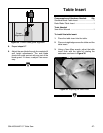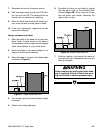
G0444/G0444Z 10" Table Saw -33-
4. Set up safety devices such as featherboards
or other anti-kickback devices.
5. With the saw unplugged from the power
source, rotate the blade to make sure it
does not come into contact with any of the
safety devices.
6. Plug the saw into the power source, turn it
ON, and allow it to reach full speed.
7. The jointed edge of the workpiece must slide
against the fence during the cutting opera-
tion.
Ripping means cutting with the grain of the work-
piece. In other materials such as MDF or ply-
wood, ripping simply means cutting lengthwise.
To make a rip cut:
1. Set the fence to the desired width of cut on
the scale.
2. Adjust the blade height so the highest saw
tooth protrudes approximately
1
⁄4" above the
workpiece.
3. Joint one long edge of the workpiece on a
jointer.
8. Using a push stick, feed the workpiece
through the saw blade as shown in Figure
45, until the workpiece is completely past the
saw blade.
Figure 45. Ripping operation.
Turn off the saw and allow the blade to
come to a complete stop before removing
the cut-off piece. Failure to follow this warn-
ing could result in serious personal injury.
Never attempt to rip a board that does not
have one perfectly straight edge Always
guide the straight edge of the board against
the rip fence. Failure to do this could result
in kickback and serious personal injury.
Ripping


















